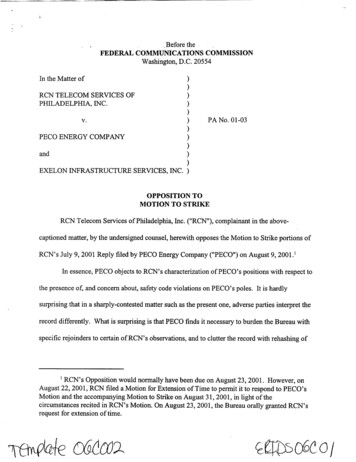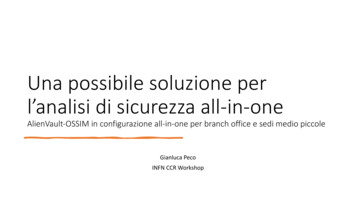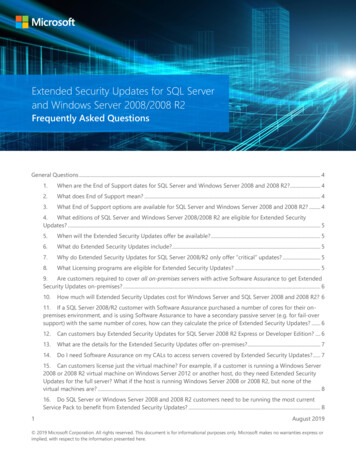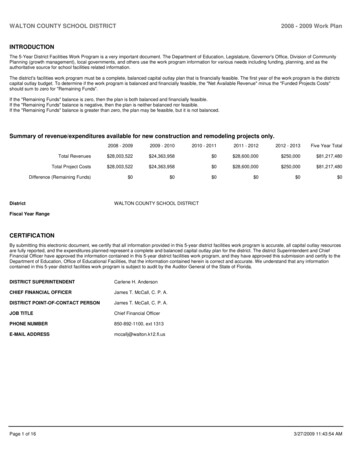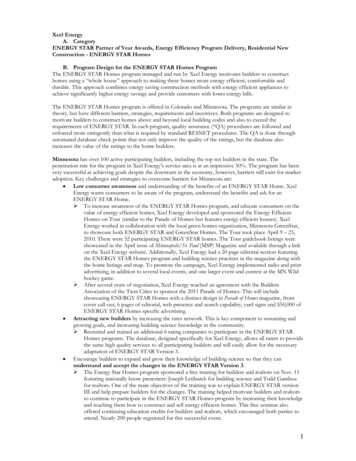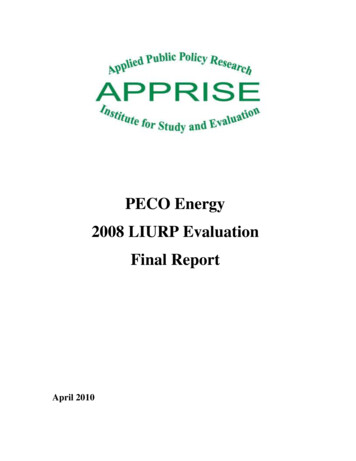
Transcription
PECO Energy2008 LIURP EvaluationFinal ReportApril 2010
www.appriseinc.orgTable of ContentsTable of ContentsExecutive Summary . iEvaluation . iPECO’s LIURP . iProgram Statistics . iiParticipant Characteristics . iiiUsage Impacts . ivMeasure Savings .vLIURP Cost Effectiveness . viBill and Payment Impacts . viiKey Findings and Recommendations . viiI. Introduction .1A. Background .1B. Evaluation Objectives and Activities .2C. Organization of the Report.2II. Low Income Usage Reduction Program .3A. Program Management and Administration .3B. LIURP Eligibility and Benefits .4C. Qualification of Leads.5D. Customer Outreach .6E. Job Types .6F. Service Delivery.7G. Energy Education .7H. Quality Control .8I. Data and Reporting .9J. LIURP Training .9K. Program Coordination .10III. Program and Participant Statistics .11A. 2008 Customer Participation.11APPRISE IncorporatedPage i
www.appriseinc.orgTable of ContentsB. 2008 LIURP Services .12C. 2008 LIURP Home Characteristics .16D. 2008 LIURP Customer Characteristics .19IV. Usage Impacts .22A. Methodology .22B. Energy Savings Impacts .23C. Measure Specific Savings .30D. Cost Effectiveness .34V. Bill and Payment Impacts .36A. Methodology .36B. Billing and Payment Impacts .36VI. Summary of Findings and Recommendations .42APPRISE IncorporatedPage ii
www.appriseinc.orgExecutive SummaryExecutive SummaryThis report presents the findings from the Evaluation of PECO’s 2008 Low Income UsageReduction Program (LIURP). LIURP provides energy efficiency services and energy educationto PECO’s low-income customers to help them reduce their energy usage and increase theaffordability of their energy bills. The Program addresses both electric and gas energy usage.This report describes the LIURP services and analyzes the impact of the Program on customers’energy usage, energy bills, and payments.EvaluationThe goals of the evaluation were to analyze the LIURP services provided and the impacts ofthe services on participating customers. The activities that were undertaken included:Process Review: Review and update of LIURP program description.Program Database Analysis: Analysis of 2008 LIURP services, homes, andcustomer characteristics.Program Impacts Analysis: Analysis of LIURP impact on energy usage, energycosts, and bill payment.PECO’s LIURPThe Low Income Usage Reduction Program (LIURP) provides education, conservation, andweatherization measures to reduce electric and gas usage. Customers must meet thefollowing usage and income eligibility criteria for program participation.Household usage levels that exceed 600 kWh per month for electric baseload, 1,400kWh per month for electric heat, or 100 ccf per month for gas heat.Residential customers with household income at or below 150 percent of the federalpoverty level (FPL), or special needs residential customers with an arrearage andhousehold income between 151 percent and 200 percent of the FPL.CAP customers are targeted for Program services, but participation in CAP is not requiredfor LIURP services. The CAP rate customer definition of high usage is 500 kWh. CAPcustomers are required to participate in LIURP if they are identified as high users.The number of customers who receive LIURP services each year is largely determined bythe annual program budget established in the settlement agreement of PECO’s electricrestructuring case (PUC Docket Numbers R-00973953 and P-00971265). The annual budgetfor 2008 was 6,475,000. In 2008, 8,812 customers received LIURP services.APPRISE IncorporatedPage i
www.appriseinc.orgExecutive SummaryPECO contracts with CMC Energy Services to administer LIURP. PECO provides CMCwith a list of eligible customers and their energy usage data. CMC recruits these householdsin descending order based on highest usage and largest arrearages. CMC also contactshouseholds who are directly referred from external organizations, including social andgovernmental agencies. CMC conducts an energy audit to determine the behavioral changesand program measures required for usage reduction. Following the audit, the auditor makesarrangements for a future visit, by one or more of five subcontractors, to install measures.Program StatisticsIn 2008, 29,988 customers were evaluated for LIURP services. There were 4,277 customerswho were ineligible for the program and 16,899 customers who were cancelled (both arelower than in 2007). The cancellations were due to customers’ lack of response to contactattempts, refusal of services, moves, and lack of landlord consent.1 In total, 8,812 customersreceived LIURP services in 2008.Table ES-1 displays how program funds were expended in 2008. In total 6.475 millionwere spent. Approximately 67 percent was for weatherization measures, 27 percent was foraudit and education, and six percent was for program administration.Table ES-12008 LIURP ExpendituresGas and Electric TreatmentsBy CategoryCategoryAmount SpentPercent of FundsWeatherization Measures 4,306,20567%Audit/Education 1,745,35227% 419,9246% 3,520 1% 6,475,000100%PECO AdministrationSolar Water MaintenanceTOTALTable ES-2 displays the distribution of 2008 LIURP jobs by job type. The table shows that64 percent of jobs are classified as baseload, meaning that measures primarily addresselectric baseload usage. However, the baseload jobs have lower job costs and represent only27 percent of total costs. The average cost for measures on these jobs was 193. Gasheating jobs represent 13 percent of jobs and 58 percent of costs, averaging 1,995 inmeasure costs per home. Electric heating jobs averaged 2,190 per home.1See Table III-3.APPRISE IncorporatedPage ii
www.appriseinc.orgExecutive SummaryTable ES-22008 LIURP Service Delivery and ExpendituresBy Job Type# of Jobs1% of JobsTotal Cost% of CostsAverage Job Cost5,62064% 1,084,57227% 1931432% 313,2258% 2,190Gas Heating1,14013% 2,273,74958% 1,995Low Usage1,54118% 215,7915% 1403314% 51,1251% 154Solar Water Heat Maintenance3 1% 1,990 1% 663Prior Year24 1% 5,283 1% 2208,802100% 3,945,735100% 448Job TypeBaseloadElectric HeatingElectric Heat Low UseTotal1There are 10 accounts that had no weatherization costs.Participant CharacteristicsPECO’s LIURP database allows for extensive analysis of home and participantcharacteristics. Some of the important findings from this analysis include:Supplemental heat usage: Over one third of the customers served through LIURPuse electric supplemental heat (3,134 customers).Air conditioning: Air conditioning is used by 97 percent of the LIURP participants(8,511 customers).Renters: PECO’s LIURP is successful in serving renters. Over 40 percent of thecustomers served are renters (3,791 customers).Vulnerable households: Fifty-three percent of the customers had a child (4,643customers) and almost 30 percent had an elderly member (2,520 customers).Poverty level: Approximately 23 percent had income below 50 percent of the FPL(1,955 customers), 44 percent had income between 51 and 100 percent of the FPL(3,873 customers), 25 percent had income between 101 and 150 percent of the FPL(2,209 customers), and nine percent had income above 150 percent of the FPL (775customers).CAP: Eighty-five percent of LIURP recipients were CAP participants (7,471customers).APPRISE IncorporatedPage iii
www.appriseinc.orgExecutive SummaryUsage ImpactsEnergy usage was analyzed for the year prior to the LIURP visit and for the year afterservice delivery was completed. The analysis included as close to a full year of data pre andpost-treatment as possible. Data were available for approximately 80 percent of the treatedhouseholds.Energy usage data were weather-normalized in the pre and the post usage period to ensurethat changes in energy usage are due to changes in usage patterns, rather than due to changesin weather. We used a degree-day normalization process to conduct this analysis. Resultswere similar to PRISM, but allowed for inclusion of a much larger number of homes.Table ES-3 summarizes the overall usage impact results.Baseload jobs had average savings of approximately 714 kWh, or 6.5 percent of pretreatment usage.Electric heat jobs had average savings of approximately 2,172 kWh, or 10.4 percentof pre-treatment usage.Gas heat jobs had average savings of approximately 103 ccf, or 9.5 percent of pretreatment usage.Table ES-3Average Usage and Savings#Pre-UsePost-UseSavings% 10.4%9.4%Electric Baseload (kWh)Non NormalizedDegree Day NormalizedPrism ,27610,139Electric Heat (kWh)Non NormalizedDegree Day NormalizedPrism 29Gas Heat (ccf)Non Normalized8821,0731,000736.8%Degree Day NormalizedPrism Normalized8825061,0871,072984979103939.5%8.7%We compared the usage impact results to historical savings results.22Table IV-3 provides the historical comparison of energy savings by job type.APPRISE IncorporatedPage iv
www.appriseinc.orgExecutive SummaryThe 2008 electric baseload jobs had lower savings than the 1999-2007 average.Savings were 6.5 percent in 2008 compared to the historical average of 9.5 percent.Weatherization spending, at 191 in 2008, was also lower than the nine-year averageof 228.Electric heat jobs had average savings that were significantly higher than the 19992007 average. Savings were 10.4 percent in 2008 compared to 7.9 percent for thenine-year average. Costs for 2008 were also significantly higher than the nine-yearaverage, at least partially because a greater percentage of electric heat jobs in 2008had major measures than in other recent years.Gas heat jobs had pre-treatment usage and savings that were lower than the 19992007 average. Pre-treatment usage was 1,087 compared to the nine-year average of1,208, approximately 10 percent lower. Gas savings were 9.5 percent in 2008, ascompared to 11.0 percent for the eight-year average. Gas heat measure costs weregreater than the nine-year average.The lower pre-treatment usage for the gas heating jobs may be due to the longevity ofPECO’s LIURP and their historical treatment of high usage customers. After so many yearsof providing LIURP to the highest use customers, there are fewer high usage customers toprovide LIURP treatments to. Additionally, recent increases in energy prices may havecaused customers to conserve energy prior to receiving services.Measure SavingsThe analysis also estimated the impact of specific LIURP measures on kWh and ccf savings.Table ES-4 displays results from this analysis. Savings for most measures were computedby running a regression model that predicted savings based on the measures provided andhome and customer characteristics. Estimates were developed for refrigerators, furnaces,boilers, and insulation.Because almost all LIURP participants received four CFLs, there was no variation in thismeasure to statistically estimate savings. Therefore, we estimated savings for CFLs byexamining total annual kWh savings for electric baseload jobs that only received CFLs.These customers saved an average of 507 kWh, much higher than the 274 kWh that mightbe expected to be saved if each of the four CFLs replaced 60 watt incandescent bulbs thatwere used an average of four hours per day.3 Therefore, we expect that a significant part ofthese savings is due to education and resulting changes in behavior.In the cost and cost-effectiveness columns of the table, we provide estimates using only theCFL costs and estimates that include the CFL costs and the audit/education costs. Evenwhen the audit/education costs are included, the cost per kWh saved over a 5-year lifetime is12 cents per kWh. This indicates that there may be potential to cost-effectively increase3(60 watts – 13 watts)*.001 * 365 days * 4 hours/day * 4 bulbs 274 kWhAPPRISE IncorporatedPage v
www.appriseinc.orgExecutive Summarysavings by providing more CFLs to LIURP participants. PECO has begun providingadditional CFLs to LIURP participants with Act 129 funding. It also indicates that theLIURP education process is very effective.Table ES-4Measure Savings EstimatesElectric BaseloadCFL OnlyRefrigeratorGas Heat - ccfGas FurnaceBoilerInsulationSavingsCost/Home /Unit SavedMeasure Life /Unit Saved OverLifetime507 ( 101)1,008 ( 269) 74/ 272 769 0.15/ 0.54 0.76512 0.03/ 0.12 0.08122 ( 41)69 ( 42)38 ( 27) 2,546 3,137 679 20.87 45.46 17.87151515 1.90 4.30 1.75LIURP Cost EffectivenessWe also analyzed the cost-effectiveness of LIURP by job type. Table ES-5 estimates thecost per unit saved based on different assumptions about measure life. The most reasonableassumption for electric baseload reduction is probably a five to seven-year measure life.Baseload electric services, at a cost of 13 cents per kWh saved with a 5-year measure lifeand eight cents per kWh saved with a 10-year measure life, are cost-effective under a sevenyear measure life assumption. Gas heat savings probably have a 10-year to 15-year measurelife. Under the 15-year measure life assumption, the cost per ccf saved is 1.93, which isclose to cost-effective with current gas prices.Table ES-5Cost Per Unit SavedBy Measure Life AssumptionElectric BaseloadElectric (kWh)Gas (ccf)Electric HeatElectric (kWh)Gas HeatElectric (kWh)Gas (ccf)APPRISE Incorporated#AverageSavingsAverageTotalCostCost YearMeasureLife4,52418471415 416 21 0.58 1.37 0.13 0.32 0.08 0.18 0.06 0.13982,172 2,578 1.19 0.27 0.15 0.11871530 197 0.37 0.09 0.05 0.04882103 2,066 20.05 4.63 2.60 1.93Page vi
www.appriseinc.orgExecutive SummaryBill and Payment ImpactsThe evaluation also included an analysis of the charges and payments made by customers inthe pre and post-treatment periods. Table ES-6 summarizes the results of this analysis.While total bills and charges declined by 40, total payments and credits increased by 77from the pre to post period. This resulted in an increase in the total bill coverage rate ofapproximately 11 percentage points.Table ES-6Bills, Payments, and Coverage RatesPre and Post-LIURP Treatment#Total Bills and ChargesTotal Payments and CreditsTotal Coverage Rate3,947PrePostAll Job Types 1,375 1,335 1,278 1,35593.6%104.7%ChangePercent Change- 40 7711.1%-2.9%6.0%11.9%Key Findings and RecommendationsPECO’s LIURP cost-effectively delivered energy efficiency services and energy educationto 8,812 customers in 2008, many of whom had vulnerable household members. They havekept program administration costs low, at just six percent of program expenditures.Reductions in energy usage were somewhat lower than in previous years. This reduction isprobably due to lower pre-treatment energy usage. PECO has been providing LIURPservices for many years, and has furnished LIURP to many of its highest usage customers.Additionally, lower pre-treatment usage may be due to higher energy prices and customers’energy conservation efforts.We have the following recommendations to continue to deliver effective services andpotentially improve savings.1. Targeting: It is a challenge to continue to find high usage customers to treat in theprogram. Lower energy savings for 2008 participants may be related to lower pretreatment usage and fewer energy saving opportunities for these households. PECOshould continue to make targeting the highest usage households a priority for theprogram.2. CFL’s: The program provides four CFLs to nearly every household served inLIURP. The measure saving analysis found that customers who only receivedCFLs had high average savings. PECO is currently providing additional CFLs toLIURP participants through Act 129 Program funding. PECO should evaluate theimpact of these additional measures.APPRISE IncorporatedPage vii
www.appriseinc.orgExecutive Summary3. Education: The high savings for households that only received CFLs, as well asprevious customer survey research conducted as part of PECO’s USF evaluation,indicate that the energy education conducted as part of LIURP is successful. Webelieve this is due to the extensive education process that occurs during the audit andthe reinforcement that occurs through letters and phone calls. PECO should continuethe emphasis on education.4. Evaluation: The evaluation methodology that has been used examines gross savings,the difference between weather-normalized pre and post usage. PECO shouldconsider using a comparison group to calculate the net savings due to the program.The net savings would be measured as the difference between the change for thetreatment group and the change for the comparison group. Because electric baseloadusage has been increasing over time, this may show a more accurate estimate of agreater reduction in electric usage that is due to LIURP. Such an analysis would alsocontrol for other factors, such as increases in energy prices, which may leadcustomers to conserve even in the absence of LIURP. Failure to account for thischange may lead to an overestimate of LIURP savings, particularly on the gas side.However, the Pennsylvania Public Utility Commission does not require the use of acomparison group.APPRISE IncorporatedPage viii
www.appriseinc.orgIntroductionI. IntroductionThis report presents the findings from the 2008 PECO LIURP evaluation. PECO’s LIURPprovides energy efficiency services and energy education to low-income households to help themreduce their energy usage and increase the affordability of their energy bills. This reportdescribes the Program services and analyzes the impact of the Program on customers’ energyusage, energy bills, and payments.A. BackgroundPECO Energy has implemented a set of Universal Services Programs to meet requirementsset by Pennsylvania’s electric and gas restructuring legislation and various Public UtilityCommission orders and agreements. The Universal Service goals are:To protect consumers’ health and safety by helping low-income customers maintainaffordable utility service.To provide affordable utility service by making available payment assistance to lowincome customers.To help low-income customers conserve energy and reduce residential utility bills.To ensure utilities operate universal service and energy conservation Programs in a costeffective and efficient manner.The Universal Services Programs include:A CAP payment assistance Program that is designed to make energy bills moreaffordable by furnishing payment subsidies.A LIURP Program that is designed to make energy bills more affordable by helping toreduce usage.A CARES Program that is designed to assist households in developing appropriatestrategies for maintaining energy service.A MEAF hardship fund Program that is designed to furnish emergency payments tohouseholds that cannot pay their energy bills.APPRISE IncorporatedPage 1
www.appriseinc.orgIntroductionB. Evaluation Objectives and ActivitiesThe goals of the evaluation were to analyze the LIURP services provided and the impacts ofthe services on participating customers. The activities that were undertaken as part of theevaluation included:Process Review: We reviewed and updated the LIURP program description.Program Database Analysis: We conducted analysis of the 2008 LIURP Programdatabase, which included data on services delivered, homes serviced, and customersserved.Program Impacts Analysis: We analyzed billing and transactions data to estimate theimpact of the Program on energy usage, energy costs, and bill payment.C. Organization of the ReportFour sections follow this introduction.Section II – Low Income Usage Reduction Program: This section describes PECO’sLIURP design and implementation.Section III – Program and Participant Statistics: This section provides descriptivestatistics on LIURP services delivered in 2008 and the customers who received theseservices.Section IV – Usage Impacts: This section analyzes the impacts of the LIURP oncustomers’ electric and gas usage.Section V – Payment Impacts: This section analyzes changes in customers’ bills,payments, and arrearages after receiving Program services.Section VI – Summary of Findings and Recommendations: This section provides asummary of the key findings and furnishes recommendations for PECO’s LIURP basedon the analyses in this report.APPRISE prepared this report under contract to PECO. PECO facilitated this research byfurnishing Program data to APPRISE. Any errors or omissions in this report are theresponsibility of APPRISE. Further, the statements, findings, conclusions, andrecommendations are solely those of analysts from APPRISE and do not necessarily reflectthe views of PECO.APPRISE IncorporatedPage 2
www.appriseinc.orgLow Income Usage Reduction ProgramII. Low Income Usage Reduction ProgramPECO has implemented a set of Universal Service Programs to comply with Public UtilityCommission Regulations. The programs are designed for low-income, residential customers.One of these programs is the Low Income Usage Reduction Program (LIURP).The Pennsylvania Public Utility Commission (PUC) requires that all electric and gas utilities inthe state offer a Low-Income Usage Reduction Program (LIURP) to their customers. PECO hascontracted with CMC Energy Services (CMC) to administer LIURP since the implementation ofthe Program in 1991. PECO and CMC worked together to create Program procedures thatcomplied with Chapter 58 guidelines, and continue to work together to design and implementProgram changes when necessary. CMC sub-contracts with five subcontractors to install majorProgram measures.The annual LIURP budget for 2008, determined by the settlement agreement of PECO’s electricrestructuring case, was 5,600,000, with 875,000 earmarked for the LIURP Gas Programthrough gas restructuring.A. Program Management and AdministrationLIURP managers and staff have many years of experience with LIURP. PECO’s analyst isresponsible for overseeing overall LIURP production, quality assurance, and the annualProgram evaluation. She is also responsible for managing the LIURP budget, refining theProgram, and analyzing CMC reports.CMC has the following staff responsible for PECO’s LIURP:LIURP Manager: The LIURP Manager has 16 years of PECO LIURP experience. She isresponsible for monitoring Program performance, including training, sub-contractorperformance and customer satisfaction. She is also responsible for coordinating Programactivities, making recommendations for and implementing Program improvements,analyzing Program data, and reporting to PECO.LIURP Office Manager: The LIURP Office Manager has 15 years of PECO LIURPexperience. She is responsible for supervising daily LIURP work activities. She is alsoresponsible for ensuring accurate and timely data input, evaluating training andperformance, managing customer service calls, and following up on referrals.LIURP Quality Control Manager: The LIURP Quality Control Manager has ten years ofPECO LIURP experience. He is responsible for providing training and technical supportto field staff and sub-contractors. He is also responsible for completing pre and postwork inspections and resolving job issues.APPRISE IncorporatedPage 3
www.appriseinc.orgLow Income Usage Reduction ProgramCMC meets with PECO monthly for performance reviews and bi-monthly for Programreview meetings. PECO conducts monthly site visits and inspections and has regulartelephone and/or e-mail contact with CMC.CMC staff conduct the LIURP audit and develop a work order for additional measures to beinstalled on subsequent visit(s) by the program subcontractors. Five subcontractors assist inthe implementation of LIURP.Premier Contractors completes weatherization work, air sealing, insulation, and airconditioner replacements.Davis Modern Heating completes house heating and water heating repair andreplacement work.McCann Company completes house heating and water heating repair and replacementwork.Colonial Electrical installs water heater timers and line voltage thermostats.Whirlpool delivers new refrigerators.B. LIURP Eligibility and BenefitsPECO customers must meet the following criteria to participate in the Program.Residential customerIncome requiremento Income at or below 150 percent of the Federal Poverty Level (FPL), oro Income between 150 and 200 percent of the FPL4 and special circumstancesUsage requirementso At least 600 kWh monthly for baseload customers5o At least 1,400 kWh monthly for electric heating customerso At least 100 ccf monthly for gas heating customersLIURP provides weatherization and conservation measures to promote usage reduction.Energy education tailored to the individual household’s energy use is also provided tofacilitate usage reduction.The following major measures may be provided:InsulationAir sealingHeating system repair or replacementAir conditioner replacementRefrigerator replacement4Since 1998, LIURP regulations have permitted companies to spend up to 20 percent of their annual Programbudgets on customers with income between 150 and 200 percent of the FPL.5CAP customers with usage over 500 kWh monthly are evaluated for LIURP.APPRISE IncorporatedPage 4
www.appriseinc.orgLow Income Usage Reduction ProgramWater heater timer installationThe following minor measures may be provided:Water heater and pipe wrapsFaucet aeratorsShowerheadsSmoke detectorsCFL bulbsC. Qualification of LeadsPECO sends a quarterly download of high usage, low-income customers to CMC.6 Themajority of LIURP recipients are recruited from this list. Customers are also referred toLIURP through the following mechanisms:PECO Universal Services staffCAP call centerCommunity Based Organizations (CBOs)Prior Program recipientsCARES customersThe electronic file downloaded from PECO contains high energy users who are alsoLIHEAP recipients, Customer Assistance Program (CAP) participants, payment troubledcustomers, or customers with multiple payment agreements. CMC reviews the lists andeliminates customers who have received LIURP within the past two years, refused Programservices, or moved within the past six months. Typically, after these removals, the remainingcustomers on the downloaded file are eligible for and receive services from LIURP.CMC screens all referrals from other sources to determine Program eligibility. If income andusage history are available and the customer is determined to be eligible, CMC enrolls t
The Low Income Usage Reduction Program (LIURP) provides education, conservation, and weatherization measures to reduce electric and gas usage. Customers must meet the following usage and income eligibility criteria for program participation. Household usage levels that exceed 600 kWh per month for electric baseload, 1,400
